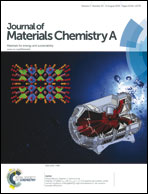Solvent-free mechanochemical synthesis of graphene oxide and Fe3O4–reduced graphene oxide nanocomposites for sensitive detection of nitrite
Abstract
We report a versatile and eco-friendly approach to prepare large-scale defect-free high quality graphene nanosheets from graphite by simple mechanochemical ball milling in the presence of KMnO4 and aspartic acid. Two foremost concerns such as surface chemistry and physical properties must be considered for potential application of the functionalized ball milled graphene. The surface chemistry was studied for the functionalized graphene anchored with 10, 20 and 30 wt% of Fe3O4 nanoparticles prepared by a simple hydrothermal process. The obtained samples were systematically studied by a variety of analytical and spectroscopic techniques to understand the structural, morphological, functional, compositional, electrical and magnetic properties. An electrochemical sensor was developed based on the prepared nanocomposite loaded on a glassy carbon electrode (GCE). The sensor based on the modified GCE exhibits good electrocatalytic activity, high sensitivity and stability for the detection of nitrite. The current response was linear over two different ranges between 0.5 and 58 μM with a wide range of 0.5 μM–9.5 mM, and low detection limit and sensitivity of 0.03 μM and 202.5 μA mM−1 cm−2 respectively. In addition, validation of the applicability of the prepared biosensor was carried out by detecting nitrite in tap, river and rain water samples.


 Please wait while we load your content...
Please wait while we load your content...